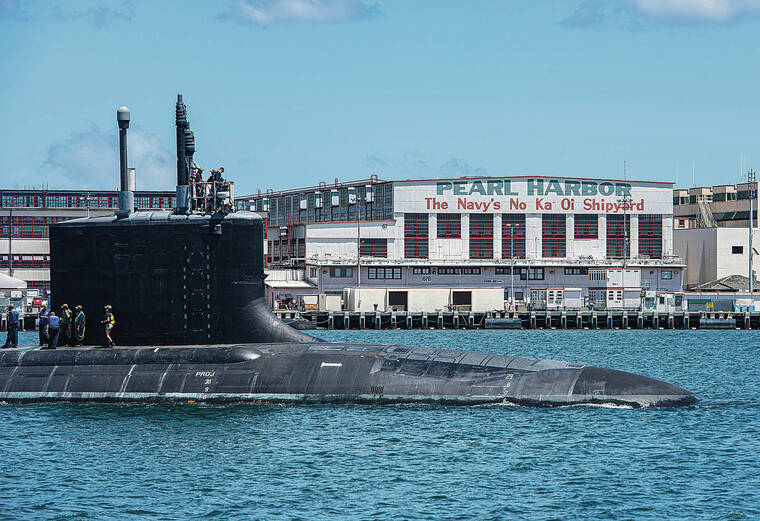Input sought on plan to modernize Pearl Harbor dry dock

COURTESY U.S. NAVY
The Virginia-class fast-attack submarine USS Missouri departs Pearl Harbor Naval Shipyard in 2020. The Navy is seeking public comment on plans for a new dry dock and a waterfront production facility at the shipyard.
The Navy is seeking public comment on plans for a new dry dock and a waterfront production facility at the Pearl Harbor Naval Shipyard as it looks to update aging facilities the service has relied on to maintain submarines.
The existing dry docks cannot accommodate newer, larger submarines the service is moving toward. The Navy estimates that construction activities would create 2,500 jobs, which would, in turn, increase state and local tax revenues for Honolulu by a projected total of $23 million annually during construction.
The comment period for the site’s draft environmental impact statement, which began Friday, and will be underway through March 21. Citing pandemic restrictions, the Navy said it would host a virtual public meeting on the project Feb. 24.
Currently, the naval shipyard is the state’s top industrial employer, with as many as 6,000 civilian workers and 500 military workers. Additional contractors work on surface ships that aren’t included in the workforce tally.
“Modernizing our four public shipyards, including Pearl Harbor, is both a national security imperative and critical to Hawaii’s economy,” U.S. Sen. Mazie Hirono, D-Hawaii, told the Honolulu Star-Advertiser on Friday. “China is investing billions in advancing their Navy” and has made it clear it wants to be the “dominant naval power in the Pacific.”
Hirono in 2021 was appointed chairwoman of the Senate Armed Services Committee’s Seapower Subcommittee, giving her significant sway over Navy funding and policy. She has long pushed for an overhaul of shipyards around the country, including at Pearl Harbor. She was a co-sponsor of the Shipyard Act, which which is aimed at modernizing public shipyards.
Don't miss out on what's happening!
Stay in touch with breaking news, as it happens, conveniently in your email inbox. It's FREE!
Over the past two decades, the U.S. military has tested the limits of its ships and aircraft — and the troops who operate them — with near-constant operations. Though the U.S. military continues to deploy troops to the Middle East, the Pentagon officials have stated that they consider the Pacific to be a top priority area of operations.
The Navy has been conducting “freedom of navigation operations” and other maneuvers in the South China Sea, a critical waterway that more than one-third of all international trade travels through. Beijing claims nearly the entire sea as its exclusive territory, leading to disputes with neighboring countries.
Chinese vessels have harassed vessels from neighboring countries and staked out disputed territory at sea. The Chinese military has stationed troops and built bases on disputed islands and atolls and gone as far as building man-made islands to station forces that assert its claims.
The Chinese navy has also rapidly expanded its inventory of warships and submarines. A Pentagon report to Congress in January noted that while China has the “largest navy in the world, with a battle force of approximately 355 platforms,” it’s expected to grow to a total of 420 ships by 2025 and 460 ships by 2030.
For its part, the Pentagon has spent billions of dollars on new ships, submarines and missiles. But in recent years it has become apparent that aging shipyards are struggling to keep up with maintenance requirements.
“The focus on shipyards modernization is essential to ensuring our Navy fleet remains the greatest fleet in the world,” said Hirono. “Keeping the new dry dock at Pearl Harbor on time and on budget is not only beneficial to taxpayers, but is imperative to ensure we have the space to perform maintenance on the Virginia-class submarines.”
However, the relationship between Hawaii and the Navy is now being tested by fuel contamination of the service’s water system that serves 93,000 people on Oahu.
Pinpointed as the source of the contamination is the Navy’s aging underground Red Hill Bulk Fuel Storage Facility, which can hold up to 250 million gallons of fuel for military ships and aircraft in massive tanks situated 100 feet above a critical aquifer that provides much of Oahu’s drinking water.
In an effort to help contain contamination, the Honolulu Board of Water Supply shut off several of its wells, and has warned that water use restrictions could be in effect this summer. Honolulu Council Chairman Tommy Waters and Vice Chairwoman Esther Kia‘aina wrote a letter last month to President Joe Biden expressing concern over the Navy’s handling of the crisis, which surfaced in November.
“We believe the Navy’s mishandling of the Red Hill crisis is jeopardizing national security interests and the overall relationship between the U.S. military and the people of Hawai‘i,” the letter stated. “The State of Hawai‘i and the City and County of Honolulu have historically supported the United States military’s strategic positions and assets in our communities for decades. This support, however, is not unconditional.”
In a news release issued Friday, the Navy said the public comment period for the proposed dry dock and a waterfront production facility at the Pearl Harbor Naval Shipyard will “be used to receive input on the project’s potential to affect historic properties.” Submitted comments will become part of the public record, and “timely, substantive” comments will be considered in the final environmental impact statement.
The new facility would replace existing Dry Dock 3. Construction would include dredging, pile driving, installation of both temporary and permanent in-water structures, demolition of existing land-side structures and construction of new temporary and permanent land-side facilities.
Visit PearlHarborDry DockEIS.org for more information about the project and to submit comments and access the Zoom link and phone number for the Feb. 24 virtual public meeting. Also, a virtual “open house” is available through March 21 at PearlHarbor DryDockEISOpenHouse.org. It presents an overview of the proposal.



